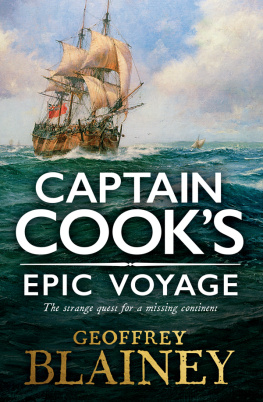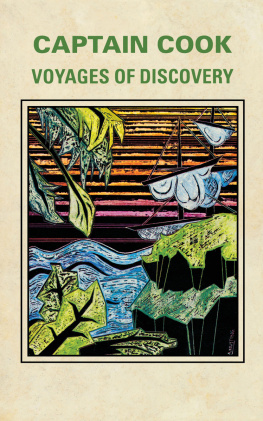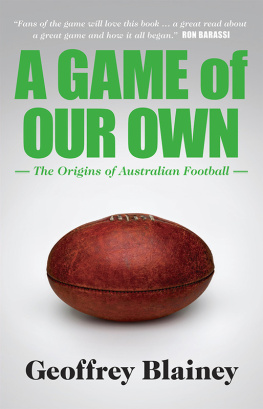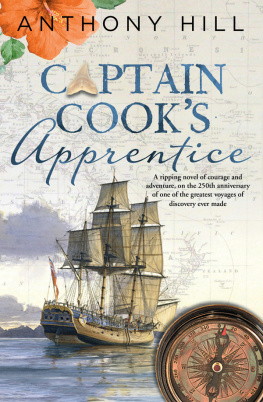Geoffrey Blainey - Captain Cooks Epic Voyage
Here you can read online Geoffrey Blainey - Captain Cooks Epic Voyage full text of the book (entire story) in english for free. Download pdf and epub, get meaning, cover and reviews about this ebook. year: 2020, publisher: Penguin Random House Australia, genre: History. Description of the work, (preface) as well as reviews are available. Best literature library LitArk.com created for fans of good reading and offers a wide selection of genres:
Romance novel
Science fiction
Adventure
Detective
Science
History
Home and family
Prose
Art
Politics
Computer
Non-fiction
Religion
Business
Children
Humor
Choose a favorite category and find really read worthwhile books. Enjoy immersion in the world of imagination, feel the emotions of the characters or learn something new for yourself, make an fascinating discovery.
- Book:Captain Cooks Epic Voyage
- Author:
- Publisher:Penguin Random House Australia
- Genre:
- Year:2020
- Rating:3 / 5
- Favourites:Add to favourites
- Your mark:
- 60
- 1
- 2
- 3
- 4
- 5
Captain Cooks Epic Voyage: summary, description and annotation
We offer to read an annotation, description, summary or preface (depends on what the author of the book "Captain Cooks Epic Voyage" wrote himself). If you haven't found the necessary information about the book — write in the comments, we will try to find it.
Captain Cooks Epic Voyage — read online for free the complete book (whole text) full work
Below is the text of the book, divided by pages. System saving the place of the last page read, allows you to conveniently read the book "Captain Cooks Epic Voyage" online for free, without having to search again every time where you left off. Put a bookmark, and you can go to the page where you finished reading at any time.
Font size:
Interval:
Bookmark:

In 1768 Captain James Cook and his crew set sail on a small British naval vessel, the boldly named Endeavour , bound for the Pacific Ocean. He was ordered to establish an observatory at Tahiti in order to record the 1769 transit of Venus, and with the skills of naturalist Joseph Banks and his team to collect natural history in this far part of the world. But Cooks brief also included a secret mission from the British Admiralty: to discover Terra Australis Incognita , an unknown southern land that might prove to be larger and richer than Australia.
Cook was not alone in this quest, and the Endeavour shared the Coral Sea and coastal New Zealand with an armed French merchant ship commanded by Jean de Surville. Eventually in 1770 Cooks ship crossed the Tasman Sea and reached the southern coast of New South Wales. Sailing north, he charted Australias eastern coastline and claimed it for Great Britain. It was the most significant of Cooks voyages, transforming the world map and the way Europeans viewed the South Pacific Ocean and its lands and peoples.
On this 250th anniversary of his major quest, Captain Cooks Epic Voyage reveals the hardships, adventure and achievements of Cooks most important voyage. Reshaping his previous book, Sea of Dangers , Professor Geoffrey Blainey takes us on a vivid journey, challenging accepted views and the intersection of myth, science and exploration.



The voyage of James Cook in the Endeavour , his first long voyage, was one of the most remarkable in recorded history. Cook not only sailed around the world, following the most difficult route any navigator had ever accomplished, but he changed the maps of the world. In heavy seas he made a more thorough search for the missing continent believed to lie somewhere between New Zealand and South America than had previously been made.
He was the first to explore most of the coast of New Zealand. He was the first so far as we know to explore a vast stretch of the east coast of Australia, and the first to explore the longest reef in the world, the Great Barrier Reef. Thanks to his talented naturalists, Joseph Banks and Daniel Solander, more plants of novelty were found during this voyage than in any previous expedition in world history. In Jakarta and Cape Town, and in the seas between them, Cook lost one-third of his crew through tropical illnesses. The ship in which he circled the world was not much larger in area than a tennis court.
My curiosity about Cook was quickened after chancing to visit many of the landmarks and seamarks of the Endeavour s voyage. To look down on Queenslands coral reefs where that ship was almost wrecked, to see the waves dash on lonely Booby Island, where Cook and Banks landed at their western exit from Torres Strait, and to approach from the ocean such harbours as Cape Town or such headlands as Cape Kidnappers in New Zealand, made me turn belatedly to Cooks detailed journals and those of Joseph Banks. New insights or unexpected strands of information appeared. After slowly reading Cooks long journal I was surprised to discover that on three occasions he ran into danger when sailing near the coast under the seductive light of the full moon; he did not seem to learn his lesson from the early escapes, and on the third occasion his ship was almost wrecked.
So I began to write a book about the Endeavour s voyage in the years between 1768 and 1771, concentrating especially on Australia. Soon I widened the book to include Cooks little-known French rival, Jean de Surville, who explored the South Pacific at the same time. I discovered or deduced that de Survilles ship was almost in sight of the sandstone cliffs near Sydney Harbour half a year before Cook approached that coastline in the Endeavour . De Survilles voyage in the St Jean-Baptiste threw light on Cooks voyage. Both explorers searched for a missing continent, and de Surville even believed that the continent might contain a colony of Jewish traders. As several French explorers competed with Cook, they were all honoured in the books original title, Sea of Dangers: Captain Cook and His Rivals .
Now I have revised and renamed this book, partly to recognise the 250th anniversary of Cooks discovery of the eastern coast of Australia. Many pages on the French voyages have been deleted or condensed. Elsewhere several hundred sentences have been revised, rearranged, augmented or deleted. In the dozen years since the first edition of this book appeared, Cooks voyage has become more controversial, especially in Australia where his discovery and its consequences are now questioned by Aboriginal leaders and by many historians. In Sydney his statue was recently vandalised. The great navigator is branded as an invader and destroyer. This book concludes with praise of Cook in the light of this controversy and also calls for recognition of the Aboriginal discoverers of Australia tens of thousands of years ago.
For valuable comments on several chapters of my manuscript, I especially thank John Foley, a Torres Strait pilot and a historian too, and Keith Farrer, a Melbourne food scientist and historian of food technology. I thank John Windholf, who corresponded with me on Torres, the Spanish navigator, and my youngest brother, Don Blainey, a round-the-world yachtsman, who discussed the implications of de Survilles inability to calculate his longitude in the Coral and Tasman seas. For other advice or information I thank Michelle Atkins, Rosemary Balmford, Eleanor Collins, John Day (skilled in geography), Bill Gillies Sr, Richard Hagen, Kate Hatch, Thomas Healy, David Hume, Stephen Pruett-Jones, Andrew, Chris and Tim Warner, and various helpful librarians in Melbourne, Sydney and Auckland. For translating documents I thank my wife and daughter, Ann and Anna Blainey. I was very fortunate to have an excellent editor, Nicci Dodanwela. In preparing this edition I am grateful to the Penguin Random House editorial team Nikki Christer, Rachel Scully and Katie Purvis. For errors and faults in the book, I alone am to blame.
Geoffrey Blainey
February 2020
In June 1767, clusters of islands were discovered by an English ship exploring the emptiness of the South Pacific. The most tantalising of the islands was Tahiti, one of the new homes of the long-distance navigators, the Polynesians. Their leisurely way of life, and abundance of food and apparent abundance of sexual activity, excited the sailors from the Dolphin during their brief stay.
The discovery of the island was to have far-reaching consequences. Here at last, thanks to Captain Sam Wallis and his Dolphin , was a base from which this largest ocean in the world could be further explored. Many questions about the Pacific were still unanswered. How large was this ocean, and how many mysterious lands did it hold? Not far from Tahiti, did there lie a strange, huge continent? Surely, if it existed, it would be inhabited, perhaps densely inhabited. That was the prevailing view of the most learned Europeans. Almost certainly it would enrich the European nation whose sailors first discovered it.
Font size:
Interval:
Bookmark:
Similar books «Captain Cooks Epic Voyage»
Look at similar books to Captain Cooks Epic Voyage. We have selected literature similar in name and meaning in the hope of providing readers with more options to find new, interesting, not yet read works.
Discussion, reviews of the book Captain Cooks Epic Voyage and just readers' own opinions. Leave your comments, write what you think about the work, its meaning or the main characters. Specify what exactly you liked and what you didn't like, and why you think so.










